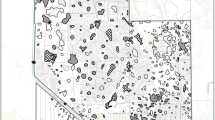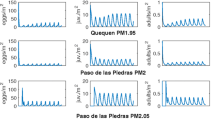Abstract
Context
The Florida Everglades has diminished in size and its existing wetland hydrology has been altered. The endangered snail kite (Rostrhamus sociabilis) has nearly abandoned the Everglades, and its prey, the apple snail (Pomacea paludosa), has declined.
Objective
We developed a population model (EverSnail) to understand apple snail response to inter- and intra-annual fluctuations in water depths over the Everglades landscape. EverSnail was developed as a tool to understand how apple snails respond to different hydrologic scenarios.
Methods
EverSnail is an age- and size-structured, spatially-explicit landscape model of P. paludosa in the Everglades. Landscape-level inputs are water depth and air temperature. We conducted sensitivity analyses by running EverSnail with ±20 % the baseline value of eight parameters.
Results
EverSnail was sensitive to changes in survival and water depth associated with reproduction. The EverSnail population varied with changes and/or differences in depth generally consistent with empirical data; site-specific comparisons to field data proved less reliable. A simulated 3-year wet period resulted in a shift in apple snail distribution, but little change in total abundance over the landscape. In contrast, a simulated 3-year succession of relatively dry years resulted in overall lower snail abundances.
Conclusions
Comparisons of model output to empirical data indicate the need for more data to better understand, and eventually parameterize, several aspects of snail ecology in support of EverSnail. A primary value of EverSnail is its capacity to describe the relative response of snail abundance to alternative hydrologic scenarios considered for Everglades water management and restoration.




Similar content being viewed by others
References
Bennetts RE, Kitchens WM (1997) Population dynamics and conservation of snail kites in Florida: the importance of spatial and temporal scale. Colon Waterbirds 20:324–329
Bennetts RE, Kitchens WM, DeAngelis DL (1998) Recovery of the snail kite in Florida: beyond a reductionist paradigm. Trans N Am Wildl Nat Resour Conf 63:486–501
Bennetts RE, Kitchens WM, Dreitz VJ (2002) Influence of extreme high water event on survival, reproduction and distribution of snail kites in Florida, US. Wetlands 22:366–373
Cattau CE, Martin J, Kitchens WM (2010) Effects of an exotic prey species on a native specialist: example of the snail kite. Biol Conserv 143:513–520
Cattau CE, Darby PC, Fletcher RJ Jr, Kitchens WM (2014) Reproductive responses of the endangered snail kite to variations in prey density. J Wildl Manag 78:620–631
Conner SL, Pomory CM, Darby PC (2008) Density effects of native and exotic snails on growth in juvenile apple snails Pomacea paludosa (Gastropoda: Ampullariidae): a laboratory experiment. J Molluscan Stud 74:355–362
Darby PC, Valentine-Darby PL, Percival HF, Kitchens WM (2004) Florida apple snail (Pomacea paludosa Say) responses to lake habitat restoration activity. Arch Hydrobiol 161:561–575
Darby PC, Bennetts RE, Karunaratne LB (2006) Apple snail densities in habitats used by foraging snail kites. Fla Field Nat 34:37–47
Darby PC, Bennetts RE, Percival HF (2008) Dry down impacts on apple snail (Pomacea paludosa) demography: implications for wetland water management. Wetlands 28:204–214
Darby PC, Fujisaki I, Mellow DJ (2012) The effects of prey density on capture times and foraging bout success of course-hunting adult snail kites. Condor 114:755–763
DeAngelis DL (1994) Synthesis: spatial and temporal characteristics of the environment. In: Davis SM, Ogden JC (eds) Everglades: the ecosystem and its restoration. St. Lucie Press, Delray Beach, pp 307–320
DeAngelis DL, Gross LJ, Huston MA, Wolff WF, Fleming DM, Comiskey EJ, Sylvester S (1998) Landscape modeling for Everglades ecosystem restoration. Ecosystems 1:64–75
Dillon RT (2000) Population dynamics and competition. In: Dillon RT (ed) The ecology of freshwater molluscs. Cambridge University Press, Cambridge, pp 171–226
Dodd CK (1993) Costs of living in an unpredictable environment: the ecology of striped newts Notophthalmus perstriatus during a prolonged drought. Copeia 1993:605–614
Doren RF, Trexler J, Gottleib A, Harwell M (2009) Ecological indicators for system-wide assessment of the greater Everglades ecosystem restoration program. Ecol Indic 9:2–16
Evans MR, Norris KJ, Benton TG (2012) Predictive ecology: systems approaches. Philos Trans R Soc 367:163–169
Gaff H, Chick J, Trexler J, DeAngelis D, Gross L, Salinas R (2004) Evaluation of and insights from ALFISH: a spatially explicit landscape-level simulation of fish populations in the Everglades. Hydrobiologia 520:73–87
Glass NH, Darby PC (2009) The effect of calcium and pH on Florida apple snail Pomacea paludosa (Gastropoda: Ampullariidae) shell growth and crush weight. Aquat Ecol 43:1085–1093
Grimm V, Berger U, Bastiansen F, Eliassen S, Ginot V, Giske J, Goss-Custard J, Grand T, Heinz SK, Huse G, Huth A, Jepsen JU, Jørgensen C, Mooij WM, Müller B, Péer G, Piou C, Railsback SF, Robbins AM, Robbins MM, Rossmanith E, Rüger N, Strand E, Souissi S, Stillman RA, Vabø R, Visser U, DeAngelis DL (2006) A standard protocol for describing individual-based and agent-based models. Ecol Model 198:115–126
Grimm V, Berger U, DeAngelis DL, Polhill JG, Giske J, Railsback SF (2010) The ODD protocol: a review and first update. Ecol Model 221:2760–2768
Gunderson L (1994) Vegetation of the Everglades: determinants of community composition. In: Davis SM, Ogden JC (eds) Everglades, the ecosystem and its restoration. St. Lucie Press, Delray Beach, pp 323–340
Hayes KA, Cowie RH, Thiengo SC, Strong EE (2012) Comparing apples with apples: clarifying the identities of two highly invasive Neotropical Ampullariidae (Caenogastropoda). Zool J Linn Soc 166:723–753
Interagency Modelling Center (2014) Central Everglades Planning Project (CEPP) tentatively selected plan model documentation report (DRAFT). US Army Corps of Engineers, Jacksonville, FL and South Florida Water Management District, West Palm Beach, FL
Jopp F, DeAngelis DL, Trexler JC (2010) Modeling seasonal dynamics of small fish cohorts in fluctuating freshwater marsh landscapes. Landsc Ecol 25:1041–1054
Karunaratne LB, Darby PC, Bennetts RE (2006) The effects of wetland habitat structure on Florida apple snail density. Wetlands 26:1143–1150
Kushlan JA (1990) Freshwater marshes. In: Myers RL, Ewel JJ (eds) Ecosystems of Florida. University of Central Florida Press, Orlando, pp 324–363
Loftus WM, Ecklund AM (1994) Long-term dynamics of an Everglades small-fish assemblage. In: Davis SM, Ogden JC (eds) Everglades, the ecosystem and its restoration. St. Lucie Press, Delray Beach, pp 323–340
Martin J, Kitchens WM, Hines JE (2007) Importance of well-designed monitoring programs for the conservation of endangered species: case study of the snail kite. Conserv Biol 21:472–481
Martin J, Kitchens WM, Cattau CE, Oli MK (2008) Relative importance of natural disturbances and habitat degradation on snail kite population dynamics. Endanger Species Res 6:25–39
NRC (National Research Council) (2012) Progress toward restoring the Everglades: the fourth biennial review. The National Academy Press, Washington
Orzack SH (2012) The philosophy of modeling or does the philosophy of biology have any use? Philoso Trans R Soc 367:170–180
Pomacea Project, Inc (2013) Literature review of Florida apple snails and snail kites, and recommendations for their adaptive management. Final Report. Submitted to the National Park Service, Everglades National Park. Available from http://www.nps.gov/ever/learn/nature/upload/ASS10-3FinalReportSecure.pdf. Accessed 5 May 2015
Rodgers JA, Schwikert ST Jr, Wenner AS (1988) Status of the snail kite in Florida: 1981–1985. Am Birds 42:30–35
Romañach SS, McKelvy M, Conzelmann C, Suir K (2014) EverVIEW data viewer: a visualization framework and exploration tool for decision support of large-scale biological planning. Environ Model Softw 62:221–229. doi:10.1016/j.envsoft.2014.09.008
Rykiel EJ Jr (1996) Testing ecological models: the meaning of validation. Ecol Model 90:229–244
Sharfstein B, Steinman AD (2001) Growth and survival of the Florida apple snail (Pomacea paludosa) fed 3 naturally occurring macrophyte assemblages. J North Am Benthol Soc 20:84–95
Sklar F, Melloy C, VanZee R, Gawlik DE, Tarboton K, Rudnick D, Miao S, Armentano T (2002) The effects of altered hydrology on the ecology of the Everglades. In: Porter JW, Porter KG (eds) The Everglades, Florida Bay, and coral reefs of the Florida Keys. CRC Press, Boca Raton, pp 39–82
Stephens PA, Sutherland WJ, Freckleton RP (1999) What is the Allee effect? Oikos 87:185–190
Stoner AW, Davis MH, Booker CJ (2012) Negative consequences of Allee effect are compounded by fishing pressure: comparison of queen conch reproduction in fishing grounds and marine protected area. Bull Mar Sci 88:89–104
Swarts FA (2000) The Pantanal: understanding and preserving the world’s largest wetland. Paragon House, St. Paul
Sykes PW Jr (1979) Status of the Everglade kite in Florida- 1968–1978. Wilson Bull 91:495–511
Sykes PW Jr, Rodgers JA Jr, Bennetts RE (1995) Snail Kite (Rostrhamus sociabilis). In: Poole A, Gill F (eds) The birds of North America. The Academy of Natural Sciences, Philadelphia, and The American Ornithologists’ Union No 171, Washington
Takekawa JE, Beissinger SR (1989) Cyclic drought, dispersal, and the conservation of the snail kite in Florida: Lessons in critical habitat. Conserv Biol 3:302–311
Valentine-Darby PL, Kell SE, Darby PC (2014) Predation on Florida apple snails (Pomacea paludosa) by native and non-native aquatic fauna, and predator-prey size relationships. Fla Sci 78:47–56
Acknowledgments
We appreciate the support of Ronnie Best (USGS, retired) and Craig Conzelmann (USGS) in facilitating the collaboration for this effort. We thank Alicia LoGalbo (National Park Service, Everglades), Rena Borkhataria (University of Florida), and Wingrove Duverney (USGS contractor) for their input into the formulation of this model. Pam Telis (US Army Corps of Engineers) provided helpful information regarding the use of EDEN water depth data. Bethany Wight (University of West Florida) provided technical assistance regarding site-specific hydrologic and snail density data. David Bucklin (University of Florida) created the Figure-1 map. We appreciate the comments from three anonymous reviewers and James Beerens (USGS) on drafts of this manuscript. Funding from the USGS National Climate Change and Wildlife Science Center project “La Florida: A Land of Flowers on a Latitude of Deserts” provided some support for DLD. SSR and DLD were supported by the USGS’s Greater Everglades Priority Ecosystem Science program. Views expressed here do not necessarily represent the views of the U.S. Fish and Wildlife Service. Any use of trade, product, or firm names in this article is for descriptive purposes only and does not imply endorsement by the U.S. Government.
Author information
Authors and Affiliations
Corresponding author
Electronic supplementary material
Below is the link to the electronic supplementary material.
Rights and permissions
About this article
Cite this article
Darby, P.C., DeAngelis, D.L., Romañach, S.S. et al. Modeling apple snail population dynamics on the Everglades landscape. Landscape Ecol 30, 1497–1510 (2015). https://doi.org/10.1007/s10980-015-0205-5
Received:
Accepted:
Published:
Issue Date:
DOI: https://doi.org/10.1007/s10980-015-0205-5




